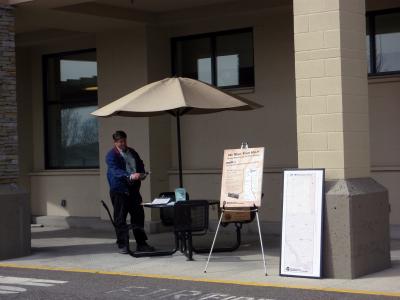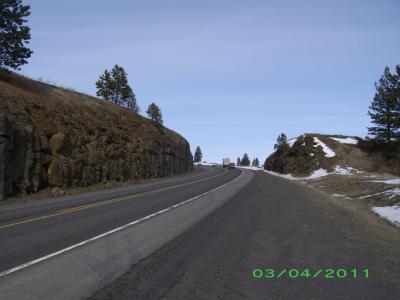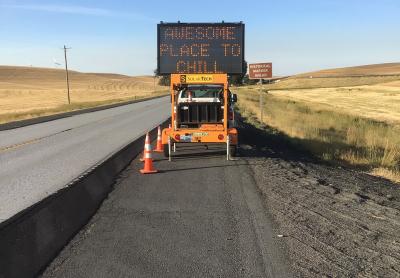Planning study news
The US 195 Corridor Crash Analysis report was completed in 2016. However, as a “living study”, work along the corridor that relates to the study continues. More passing lanes have been added, shoulder and centerline rumble strips installed, and a host of educational efforts have been implemented through the Palouse Regional Transportation Planning Organization (RTPO) and Washington State University. Additional information regarding other initiatives since the completion of the report, including those highlighted above, can be found on the Outcomes tab below.
Purpose
The US 195 Corridor Crash Analysis is a traffic safety study that focuses on:
- Identifying the most common circumstances or trends that contribute to serious and fatal injury crashes along the corridor.
- Identifying low-cost solutions or countermeasures most likely to reduce serious and fatal injury crashes along the corridor.
Planning study report
Study description and alignment with Target Zero
The US 195 Corridor Crash Analysis is a traffic safety study that focuses on serious and fatal crashes and low-cost countermeasures that have the potential to reduce these type of injury crashes. The study aligns with the Washington state Strategic Highway Safety Plan: Target Zero, that addresses the Governor’s initiative to reduce traffic fatalities and serious injuries to zero by the year 2030. This study looked at the corridor traffic safety performance and identified low-cost solutions/countermeasures that have the greatest potential to reduce serious and fatal injury crashes.
Study location
US 195 is located in southeastern Washington state. The 80-mile study section includes the area between milepost limits 0.00 and 80.10. This is approximately between the Idaho state line (about 8 miles north of the Lewiston/Clarkston area) and Spangle, Washington (about 13 miles south of I-90 and the city of Spokane).
Corridor use
US 195 is a major regional north/south freight corridor. It connects a significant agricultural area known as the Palouse with I-90. It is a primary route for travelers seeking access to medical services, commercial/retail business centers, the Spokane International Airport, Washington State University (Pullman and Spokane), University of Idaho, and various Spokane and Whitman County communities.
Study Involvement
WSDOT’s Eastern Region Planning office conducted the study in collaboration with many partners:
- Palouse Regional Transportation Planning Organization (RTPO)
- Lewis-Clark Valley Metropolitan Planning Organization (MPO)
- City of Colfax Fire Department
- City of Pullman Engineering
- City of Pullman Planning
- City of Pullman Fire Department
- City of Rosalia Fire Department
- Spokane County Fire Department
- Spokane County Traffic Engineer
- Spokane County Target Zero Task Force
- Whitman County Engineering
- Whitman County Planning
- Whitman County District Court
- Whitman County Fire Department
- Whitman County Sheriff
- Washington State University Police and Public Safety
- Washington State University Transportation Services
- University of Idaho Transportation Services
- Washington State Patrol Colfax and Spokane detachments
- WSDOT Colfax Maintenance
- WSDOT Public Transportation
- Coast Transportation
- Northwestern Trailways
- Pullman Airport
- Pullman Transit
- Wheatland Express
Study data sources
Crash data
This study included a review of five years of US 195 crash data from the years 2005 through 2009. This information provides crash location, injury severity, crash type, roadway conditions, weather and light conditions, driver contributing circumstances, sobriety, occupant restraint usage, vehicle information, and pedestrian or bicyclist information.
Enforcement
This study included a review of five years (2005 - 2009) of US 195 enforcement data provided by the Washington State Patrol. The data includes information regarding location, infraction type, and driver age and gender.
Community input
To gain insight into the needs of the communities that rely on US 195, listening posts and a survey were the two tools utilized for this study. The listening posts were held at local gathering places and the survey was distributed online and via paper copies.
We asked the public about what concerns they have when travelling the study corridor, such as how they view other drivers’ behavior, what behaviors they engage in while driving, how they rank crash reduction strategies by importance, their awareness of existing highway safety programs, and anything else they thought was important for us to know.

June 2010 - January 2016
The study was funded by the Washington State Department of Transportation.
Community engagement lessons
Feedback from a public survey, listening posts and study partners provided the following:
Opposite direction crashes are a primary public concern. This was followed by winter weather road conditions, distracted drivers, impaired drivers, speeding drivers, slow moving vehicles and run-off-the-road crashes.

Frequent passing by others ranked first in the survey as a public concern regarding the other drivers' behavior. Frequent passing was followed by concerns regarding distracted, aggressive, and speeding drivers.

Trends leading to fatal and serious injury crashes
During the five-year study period (2005-2009), there were 16 fatal and 23 serious injury crashes recorded that overall resulted in 17 fatalities and 40 serious injuries within the 80-mile study section. The data show that:
- Opposite direction crashes accounted for 11 of the 16 fatal injury crashes.
- Run-off-the-road crashes accounted for the other five (5) fatal crashes.
- Driver behavior such as speeding, driving under the influence, aggressive, distracted, and drowsy driving was recorded as a contributing factor in 31 out of the 39 fatal and serious injury crashes. Seven (7) of the eight (8) remaining crashes involved a vehicle crossing the centerline resulting in an opposite direction crash, but no driver behavior was recorded as a contributing factor.
- Multiple vehicle crashes accounted for 27 of the total 39 recorded fatal and serious crashes.
- Heavy truck drivers had no recorded contributing circumstances for any of the six (6) fatal injury crashes involving a heavy truck.
- Males represented 68% of all involved drivers.
- Young drivers (age 16 to 25) comprised 28% of all involved drivers.
- Roadway conditions for the majority of these crashes were on a dry roadway surface, during daylight hours, on a straight roadway section.
Challenges
No one entity alone is able to meet the challenge of reducing the crash frequency or injury severity along the US 195 corridor.
Reducing crash potential along the corridor will require effort by drivers along with the partnership of various organizations. As indicated in the study findings, crashes along the corridor are typically the result of driver, roadway, vehicle and/or other factors that are beyond control of any one agency.
Limited funding is a major challenge that many agencies share. For WSDOT the US 195 study section currently has limited funding opportunities. State law requires WSDOT to prioritize safety projects based on statewide needs where the greatest benefit can be realized for the dollars spent.
The US 195 study segment does not prioritize in regards to deficiencies and needs when compared to other state roads and is unlikely to readily prioritize for engineering safety funding in the near future. As engineering countermeasures are implemented on higher priority routes, this segment may move up on the priority list.
This analysis shows that the study segment already incorporates many of the identified countermeasures and the operation and safety performance is consistent with the modeled expectation.
Recommendations
Findings indicated crashes along the corridor were attributed more to driver behavior than roadway design. However, to find solutions that worked for both behavior and design, the four E’s (enforcement, engineering, emergency medical services, and education) of the Washington State Strategic Highway Safety Plan – Target Zero became part of the evaluation process.
A list of study recommendations can be found in the study document. US 195 Corridor Crash Analysis (PDF 11.4Mb)
As a “living study”, the work continues
The Washington Department of Transportation (WSDOT) and our partners are committed to ongoing collaboration towards the reduction of crash occurrences along the US 195 study corridor. Collaboration efforts have continued since the study document was completed in 2016, with the goal of incremental implementation and monitoring of improvements, as well as the modification of driver behaviors. The following is a list of actions that have since been taken to reduce the occurrence of crashes along the US 195 corridor, categorized by each of the four E's from the Washington State Strategic Highway Safety Plan - Target Zero plan: enforcement, engineering, emergency medical services, and education.
Enforcement
Crash pattern and timeline data were shared with the Washington State Patrol (WSP) during the study. WSP noted that state troopers prioritize their crash prevention efforts at locations and times that are consistent with patterns of crash occurrences. However, the breadth of the geographic area where troopers work is influenced by the following:
- Narrow vs. broad crash area.
- The availability of safe locations to stop traffic violators.
- Time available for enforcement vs. response to calls for service which is also a function of staffing.
Some motorists’ driving practices are influenced by the probability of being stopped by a trooper and the potential of receiving a traffic ticket. Trooper visibility on the highways has a positive impact on driver practices.
Engineering
- Added passing lanes in 2017 as a result of a US 195 South passing lanes evaluation.
- Installed centerline rumble strip for the entire US 195 study corridor in 2010.
- Installed shoulder rumble strips from milepost 8.91 to milepost 88.55 in 2020.
Emergency medical services
No known strategies have been implemented at this time.
Education
Palouse Driver Safety Campaign
The Palouse Regional Transportation Planning Organization (RTPO) established its first Palouse Driver Safety Campaign in 2016 in response to data showing a high frequency of serious injury and fatal crashes along SR 26 and US 195, and the community petitions that followed to improve these two highways. The Palouse Driver Safety Campaign provides the following:
- An online pledge to commit to being a safe driver and help achieve Washington's Zero Traffic Death goal by 2030
- Live social media updates that include WSDOT, Washington State Patrol, and WSDOT Passes tweets along with Palouse Driver Safety Facebook page updates
- Relevant WSDOT live traffic camera feeds and travel alerts
- Extreme weather 'How to’ videos that give extreme weather driving tips and what to do during various types of extreme weather events
- Safe driving tips related to winter driving, drowsy driving, distracted driving, young drivers, aggressive drivers, and emergency car kit
- Content for the annual Driving Education Week in April, which features extensive community outreach events at schools, clubs, festivals and other community events
- The community invested for $50,000 for the continuation of Palouse driver education campaign
Please visit the Palouse Driver Safety Campaign (Website) for more information.
Washington State University (WSU) Driver Safety Committee
The Palouse RTPO and WSDOT initially started a driver safety public awareness campaign; however, over time they partnered with numerous other agencies including WSP, WSU, City of Pullman, local police and sheriff offices, Washington Traffic Safety Commission, and Whitman County. Partnering with WSU led to the WSU’ Driver Safety Committee, where partners routinely meet to discuss strategies to communicate and improve the driving behavior and safety of students, their families, and community members who travel for school and sports in and out of the Palouse region.

WSDOT deployed variable message sign messages that were collaboratively developed with our partners and placed during major WSU events (such as the VMS Sign on US 195).
The primary goal of these groups is to increase public awareness, driver safety-related education, and weather updates, and to instill safe driving habits for travelers along the US 195 corridor in support of the Washington State Target Zero goals.
Current initiatives (2016 - Ongoing)
- The WSU Driver Safety Committee continues to collaboratively develop strategies and partner with organizations with specific focus on the WSU student population.
The Palouse Driver Safety Campaign hosts listening sessions and one-day informational conferences where people share their personal experiences and stories about safe driver behavior and the US 195 corridor. - The Palouse Driver Safety Campaign developed and managed a social media campaign for US 195 corridor that grew to almost four 4,000 social media followers, over 3,000 student (safe driver) pledges, and participated in more than 110 in-person community events.
The Palouse Driver Safety Campaign held local and regional driver safety events and published a variety of online content (almost 60 blogs, thousands of social media posts, and multiple videos and audio recordings), created hundreds of radio commercials, and facilitated many other activities since 2016. - In 2021, WSDOT Eastern Region partially funded the final effort of the Palouse Driver Safety Campaign.
In July 2021, the Palouse RTPO and Policy Board determined it could no longer fund the Palouse Driver Safety Campaign, and the program was discontinued at the end of August 2021. However, the web content produced for the campaign will remain available.
Bonnie Gow
Senior Transportation Planner
Email: Bonnie.Gow@wsdot.wa.gov
WSDOT Eastern Region Planning
Address: 2714 N Mayfair St Spokane, WA 99207
Charlene Kay, PE
Eastern Region Planning and Strategic Community Partnership Director
Email: Charlene.Kay@wsdot.wa.gov
Phone: 509-234-6195
Address: 2714 N Mayfair St Spokane, WA 99207
